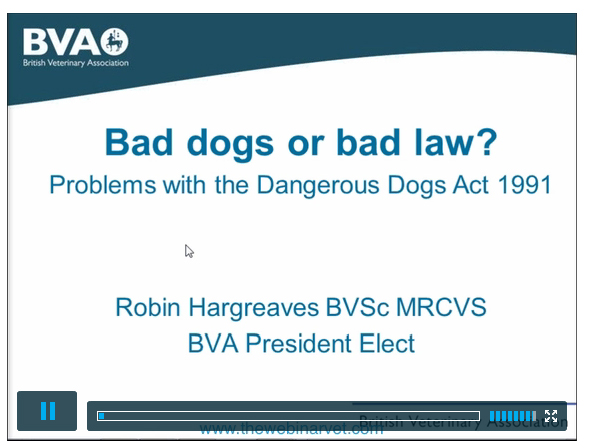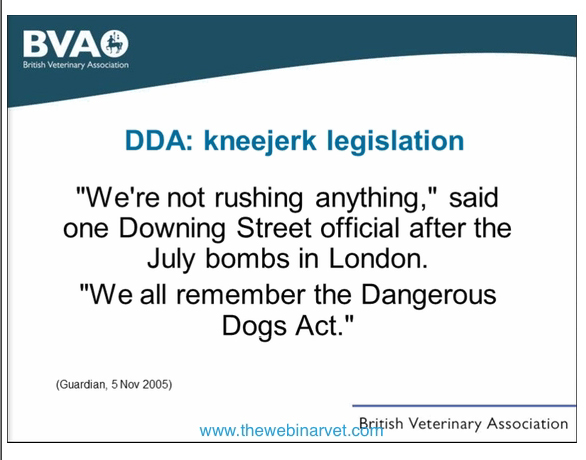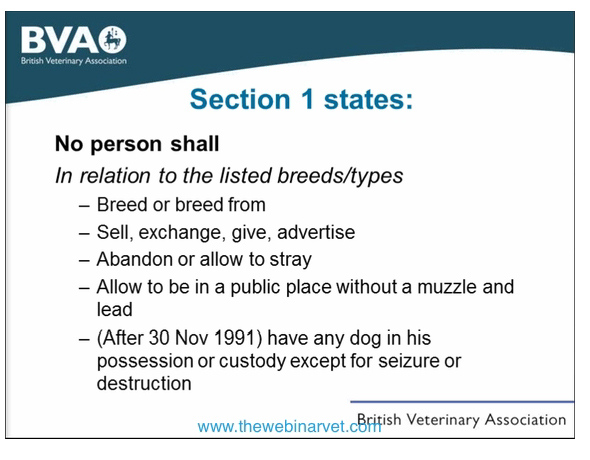February 1, 2013Comments are closed.dogs
The British Veterinary Association details the problems with their country’s 20yo breed specific legislation – namely, that it doesn’t work. Oops. Sorry about all the dead dogs.
This week the British Veterinary Association (BVA) and The Webinar Vet joined forces to deliver an informative and thought-provoking webinar on dangerous dogs.
The webinar, available to view at www.bva.co.uk/dangerousdogs, was presented by BVA President Robin Hargreaves under the banner “Bad dogs or bad law? Problems with the Dangerous Dogs Act 1991”.
In the webinar small animal practitioner Robin outlined the legislation as it stands across the UK and explained what action the BVA and others have taken in campaigning to move away from breed-specific legislation towards a more preventive approach.

Over 21 years old
Triggered by three events:
– April 1989 – Kellie Lynch (11-year-old killed by family friend’s two Rottwielers)
– 8th May 1991 – Frank Tempest (adult who recieved horrific facial injuries by roaming pack of ‘pit bulls’)
– 18th May 1991 – Rukhsana Khan (young girl, survived but very badly injured)
(more info The Independent)
Just days later, on the 22nd May 1991 – Dangerous Dog Bill put to parliament.
25 July 1991 – Signed into law
The law detailed;
The prohibition on ownership of certain breeds of dogs, and allowed provision for other breeds of dogs to be added.
‘Dangerous Dog Act’ kneejerk legislation
Drafted in a matter of days, the laws have become a case study for what NOT TO DO when under pressure from the community to ‘do something’.

Designed to do two things.
Criteria for success #1 – Get rid of pit bulls/fighting dogs
In 2005/6 – 35 ‘pit bull type’ dogs were seized
In 2008/9 – 719 ‘pit bull type’ dogs were seized
18 years later there are more dogs in the community and still being seized. The breed hasn’t simply ‘died out’.
Criteria for success #2 – Reduce dog bite incidents
1997 – 219 hospital admissions from dog bites
2010 – 6118 hospital admissions from dog bites
Even allowing for improved reporting, there is still more people being injured by dogs.
Created a ‘status dog’ culture.
Increase in popularity/fashion of strong, muscular breeds, hovering on the edge of legality.
Problems with vets treating dogs that could potentially be a restricted breed. Liability if the dog harms someone
DDA key points and criticisms
1. BSL Section #1 – prohibited dogs
– Pit bull type
– Japenese Tosa
Shortly after...
– Dogo Argentino
– Fila Brasileiro
There is also the provision to ‘expand the net’
– any dog appearing to the Secretary of State to have been bred for the purpose of fighting.

There are many people looking to strengthen and widen the laws to include additional dogs breeds. Suggestions include;
Sharpeis
Akitas
Irish Staffordshire Bull Terrier
American Bulldogs
Border Collies
What is a pit bull terrier? It is a subjective assessment, only the court can decide. The courts work from the American Dog Breeders Asssociation breed standard, which is an outline of the ‘ideal’ ‘pit bull terrier’. The laws are not a genetic definition – any pup could potentially grow into a ‘pit bull type’. If it looks like a pit bull terrier, than it is one.
Litter mates may or may not be PBT type.
Large amount of money is spent debating whether the dog meets the standard.
There is no genetic tests available because it’s a physical characteristics based laws not a breed based laws.
1991 – just before the Act was passed, the Index of Exempted Dogs was opened. This allowed owners to keep their restricted breed dog (if they – register it – microchip – desexed – muzzle in public – 3rd party insurance)
This Index was closed 30 November 1991. All dogs deemed to be ‘pit bulls’ had to be destroyed after this date.
After lobbying the Index was reopened 1997
Theoretically the breed should have become extinct, but the experience actually was that people simply didn’t comply.
If you suspect your dog may be of type, there is no ‘owner led’ applications to be added to the Index of Exempted Dogs – the only people that can add dogs is the courts.
Once you have approached the authorities to get on the exempted dog – the dog must be seized – you can only get back, if it isn’t prohibited.
But, the burden of proof is reversed – if a dog is believed to be a ‘pit bull type’ – you have to prove that it isn’t.
Making coming forward with a dog you suspect of being of type, risky. The dogs in kennels for months, and the authorities can still charge you with a Section #1 = a criminal record.
There are numerous health and welfare issues surrounding seized dogs.
Determining breed in the courts can take months and month – dogs stuck in kennels. Not handled. Skin problems. Welfare issues. Kennel behavioural problems. Dogs less healthy than they were when they were seized.
The DDA applies to all of the UK, but each country is able to alter and make its own legislation.

“The BVA has been lobbying the Government and Opposition hard for a change in dangerous dogs legislation and so we are delighted that the Government is now considering reforming the hugely unpopular and ineffective Dangerous Dogs Act 1991.
“The BVA believes very strongly in the principle of deed not breed – targeting dogs for their actions, not what they look like – and we hope to see new legislation that tackles the actions of irresponsible pet owners that can cause dogs to become aggressive.
“We therefore support the concept of control notices, which is being pursued in Scotland through the Control of Dogs (Scotland) Bill, and the proposal for compulsory microchipping to ensure all dogs can be identified.
“However, the failure of the 1991 Act is rooted in the fact that it was drafted in a highly political knee-jerk response to a number of incidents. Politicians should learn from these mistakes and resist using the issue as a political football during the General Election campaign.
“The welfare charities, vets and Kennel Club have reached consensus on the need for the law to change and politicians of all parties should aim to agree the way forward.”
BVA website 2010
An independent report on dog health and welfare today called for legislation on dangerous dogs to be updated to move away from current breed-specific legislation, which is failing to protect both humans and animals.
Professor Bateson’s report focused on the welfare issues relating to the breeding of dogs and includes a specific recommendation that “the Dangerous Dogs Act should be amended to apply to all dogs that have been shown to be dangerous rather than to specified breeds and should address the problem of dogs being bred and reared specifically as weapons or for fighting.”
The British Veterinary Association (BVA) has welcomed Professor Bateson’s recommendation, which adds fuel to the wide-ranging calls by the veterinary profession, Kennel Club and animal welfare charities that new legislation is required to tackle the growing problem of weapon dogs.
The current legislation – the Dangerous Dogs Act 1991 – bans certain breeds which means huge amounts of public money are spent kennelling non-aggressive seized dogs while their breed is determined, causing suffering for the dog and its family. It also ignores the fact that any animal can become aggressive and dangerous and can lead to a false sense that non-banned dogs will be safe.
Commenting, Nicky Paull, Past President of the British Veterinary Association, said:
“We are delighted that Professor Bateson has added his significant opinion to the call for the dangerous dogs law to be updated.
“The current rules have huge welfare implications for the thousands of dogs who are seized every year and kept in police or local authority kennels away from their families.
“Moreover, as Professor Bateson points out, they are having no impact on the number of people hospitalised by dog attacks.
“We understand that parliamentary time is scarce, but tackling this growing problem should be a priority for any government wishing to reduce the cost to the public purse, protect the public and reduce suffering of animals.”
Further Information
The British Veterinary Association is a member of the Dangerous Dogs Act Study Group (DDASG) which campaigns for a change in the law. Other members include the Kennel Club, Battersea Dogs & Cats Home, Blue Cross, Dogs Trust, Royal College of Veterinary Surgeons, Wandsworth Borough Council and Wood Green Animal Shelters.
BVA Website 2010